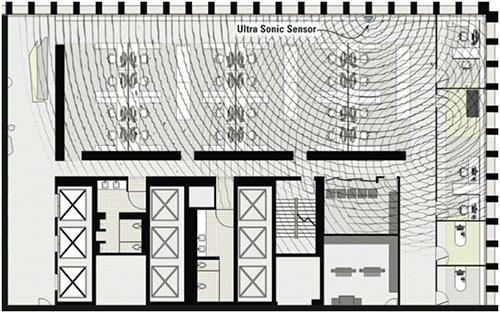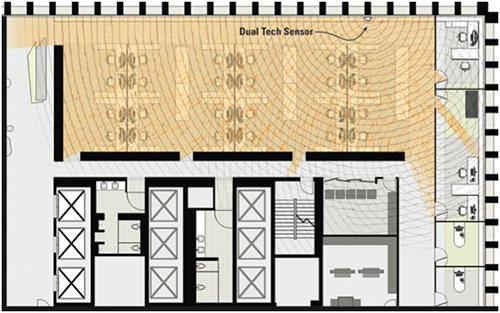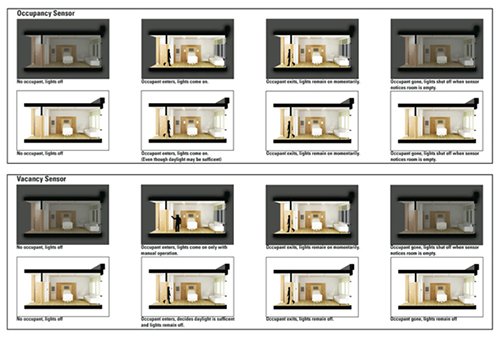In a high-performance office building, lighting can account for 20% of energy use. Properly applied, lighting controls can easily reduce that portion by 25%. But, as with any high-performance strategy, there are subtleties to the technology and application. In this article, we’ll explain the basics of occupancy sensors and their important counterpart, the vacancy sensor.
Occupancy sensors have been around for decades and, when used correctly, can be a highly efficient means for saving energy, reducing light trespass, increasing security and lamp life, and decreasing fixture maintenance. However, when using some of the older technology sensors or when using sensors in inappropriate conditions, the results can be undesirable and uncomfortable for occupants.
Because of inappropriate use of inferior sensor technology in the past, there is a perception among users that occupancy sensors do not work well. Newer technologies are rapidly turning that perception around to where we see virtually no occupant complaints regarding sensor use. The widespread use of dual technology sensors have almost completely eliminated the common misperception that the lights will turn off while an occupant is present but sitting still. Below is a discussion of the basics of occupancy sensor technology.
Passive Infrared Motion Detection
Passive Infra-Red (PIR) occupancy sensors are best for detecting major motion like an occupant walking through a space. PIR works by detecting movement of heat sources in the space. It only detects heat in its direct range of view.
Advantages: Cheap, small form factor, low power requirements and great for wireless applications.
Limitations: Coverage is directional and limited to line of sight; detects only major movement and so are prone to a false-off.
The illustration below shows where a PIR sensor would detect major motion and trigger lights in an open-office space. The benefit is that a person walking in the room next to the space would not trigger the lights to turn on, but the drawback is that only major motion is detected.

Ultrasonic Motion Detection
Ultrasonic technology in occupancy sensors is excellent for minor motion detection. This makes ultrasonic a good option where small movements such as typing at a computer desk take place for extended periods of time. Ultrasonic works by emitting a pulse into the space and receiving the bounce back. When there is movement in the space, the bounce back is read differently and the sensor knows there is movement in the space. This technology is capable of ‘seeing’ around corners.
Advantages: Can ‘see’ around objects, detects minor movements.
Limitations: Requires location specific commissioning, higher power requirements, prone to false-on triggers.
The illustration below shows the much broader sensing area of an ultrasonic detector – compare to the PIR illustration above.

Dual-Tech Motion Detection
Dual-tech combines both Ultrasonic and PIR sensor technologies to provide optimal detection, with minimal ‘false alarms.’ The occupancy sensor will not turn on the lighting until both PIR and Ultrasonic elements are triggered. The benefit here is that the minor motions of typing at a computer are picked up with the ultrasonic technology, but the lights aren’t turned on from a person in a different room based on ultrasonic bounces. In addition, once the light is turned on the sensor only needs one of the technologies to keep the lights on. This helps ensure the lighting is not turned off while the occupant is in the space.
Advantages: Detects both major and minor movement, limits false on and false off.
Limitations: higher price, though the discrepancy is small and diminishing.

Key Insight: Occupancy vs. Vacancy Sensors
Use of occupancy sensors in a daylit space can mean that lights come on when they are not needed. In these conditions, a change of the control sequence can shift the operation from an occupancy sensor to a much more useful vacancy sensor. Vacancy sensors assume that a user will turn the lights on manually, typically via a wall switch. The vacancy sensor will then monitor the space to turn lights off if the space is then vacant for a specified length of time.
Occupants in daylit spaces often need no additional electric lighting to perform basic tasks. Glumac lighting designers have found that lighting energy use will decrease when users are given control of their lighting and access to daylight because lights will only be turned on when needed. Further, sensor operation in a vacancy sensor scenario is much less obtrusive than an occupancy sensor. The only time users should notice that there is sensor control is when they come back to a space to find the lights turned off automatically.
Using the standard “automatic-on” occupancy sensors within most spaces that have no natural light makes sense because the lights should always be needed when someone enters, as there is no other light source in the space. But for spaces with daylight, the “automatic-off” of vacancy sensors is typically preferable.

Recommendations
The goals of integrating appropriate lighting controls into any design are to improve comfort and usability for occupants, and to decrease lighting energy use. When properly understood and applied, occupancy and vacancy sensors can do both. To sum up the basics:
- Seek dual technology sensors whenever the budget allows.
- Dual-technology occupancy sensors are recommended in most interior spaces with no available daylight.
- Dual-technology vacancy sensors are recommended in most perimeter spaces with available daylight.
In a future Sustainability Matters issue, we’ll continue the discussion with an article on the intricacies of daylight sensors and automatic dimming.
For more information on lighting, please email us at [email protected].

